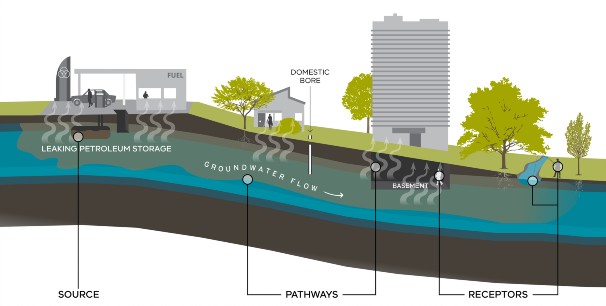When contamination is not managed, it can cause harmful changes in land or groundwater quality. These changes can pose a risk to human health and the environment.
There are duties that apply to anyone managing or controlling contaminated land and groundwater. These involve managing risks of harm from contamination.
People often cannot see land contamination. Understanding how contamination causes harm can help you manage risks.
Some substances can cause harm to human health and the environment, including:
- solvents
- oils
- pesticides
- heavy metals
- industrial waste.
For contamination to pose a risk of harm, there needs to be a:
- source – where the contamination comes from
- pathway – how the contamination spreads
- receptor – who or what the contamination could impact.

Source, pathways and receptors
Source
The source is where the contamination comes from.
For example, a disused underground petroleum storage tank could leak petroleum hydrocarbons into soil. Petroleum hydrocarbons are chemicals found in fuels.
Pathway
Pathways are how the contamination spreads to reach a receptor. Common pathways include:
- groundwater
- soil
- air.
Pathways are linked to exposure routes. This is how a receptor – for example, a person – is exposed to the contaminant. Common exposure routes for people include:
- skin contact
- ingestion
- inhalation.
For example:
Source
A disused underground petroleum storage tank leaking petroleum hydrocarbons.
Pathways
- Petroleum hydrocarbons contaminate the soil and move into groundwater.
- Contaminated groundwater moves off site. It may flow through utility trenches.
- People water their gardens with contaminated groundwater.
- Vapour emissions from contaminated groundwater or soil enter buildings located above the contamination.
Receptor
The receptor is who or what the contamination could impact. Receptors can include:
- children
- workers
- residents
- the environment, such as animals, plants and waterways.
For example:
Source
A disused underground petroleum storage tank leaking petroleum hydrocarbons.
Receptors
- People in nearby buildings could breathe in vapours from chemicals in the land or groundwater.
- The health of construction workers on and off site could be affected by contamination.
- Nearby surface water bodies could become contaminated – for example, dams, creeks, rivers, lakes, pools, ponds, puddles and water in stormwater drains.
Harmful impacts
Contamination can cause a wide range of harmful impacts to receptors. The impacts depend on the exposure duration. Short-term exposure to high levels of chemicals can cause serious effects. Long-term exposure to lower levels of chemicals can also have effects.
In this example, impacts could include the risk of:
- explosion
- cancer caused by long-term benzene exposure
- other health effects, including severe irritation and effects on the central nervous system.
Updated

